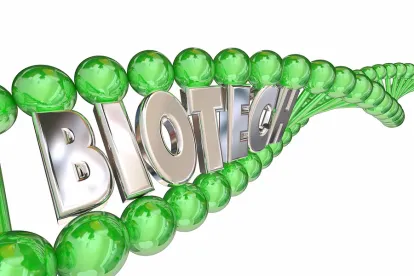Addressing patent eligibility under 35 USC § 101 for gene-related patents, the US Court of Appeals for the Federal Circuit affirmed the district court’s grant of summary judgment of invalidity, finding that the primers used to determine the presence of the pathogenic bacteria were indistinguishable from naturally occurring DNA. Roche Molecular Systems, Inc. v. Cepheid, Case No. 17-1690 (Fed. Cir. Oct. 9, 2018) (Reyna, J) (O’Malley, J, concurring).
Roche owns a patent directed to a diagnostic test and methods of using the test to determine the presence of the pathogenic bacteria Mycobacterium tuberculosis (MTB). The underlying technology was based on a discovery by Roche scientists that MTB contains 11 “signature nucleotides” that could be used as a fingerprint identifier. The inventors subsequently developed a diagnostic test involving amplification by polymerase chain reaction (PCR) of a patient’s DNA sample to determine if any of the signature nucleotides are present. The resulting patent comprised two types of claims: (1) composition of matter claims for primers used in the PCR, and (2) method of detecting MTB using PCR.
Roche filed a patent infringement case against Cepheid based on its sale of Xpert® MTB/RIF Assay, an assay that can detect MTB in a biological sample and can identify rifampin-resistant MTB. Cepheid filed a motion for summary judgment, arguing that all of the asserted claims were directed to patent-ineligible subject matter under 35 USC § 101. The district court granted Cepheid’s motion, finding that the primer claims, which have genetic sequences identical to those found in nature, were indistinguishable from those held to be directed to non-patentable subject matter, and were thus invalid. The court also found that the method claims were invalid because the use of non-patentable primers to bind to newly identified naturally occurring signature nucleotides using the well-known, routine process of PCR in a conventional way does not transform the claimed methods into patent-eligible subject matter. Roche appealed.
The Federal Circuit affirmed. The Court found that the claimed primers were structurally identical to their corresponding nucleotide sequences on the MTB gene found in nature and were thus indistinguishable from those held to be non-patentable subject matter in the Supreme Court of the United States’ 2013 decision in Ass’n for Molecular Pathology v. Myriad Genetics, Inc. (IP Update, Vol. 17, No. 6) and the Federal Circuit’s 2014 decision in In re BRCA1 (IP Update, Vol. 18, No. 1). In BRCA1the Court broadly held that DNA primers do not have a different structure from those found in nature and are thus not patent eligible. The Court found nothing that “transformed” the claimed naturally occurring phenomenon into patent-eligible subject matter. Judge O’Malley’s concurring opinion agreed that under the holding of BRCA1, the present claims were invalid; however, she proposed that the Court should revisit its holding in BRCA1 at least with respect to the primer claims since the issues raised on appeal were the result of an underdeveloped record.
Turning to the method claims, the Federal Circuit noted that Roche’s diagnostic test amounted to a valuable contribution to science, but nonetheless found that the method claims were invalid because they utilized well-known and conventional PCR primers to identify a naturally occurring phenomenon. The Court noted that the method claims assert that if an investigator detects a signature nucleotide from a sample, the investigator knows the sample contains MTB. This relationship exists in nature apart from any human action, meaning that the method claims are directed to a natural phenomenon. While Roche argued that it was unprecedented to use PCR in the detection of MTB, the Court responded that many groundbreaking discoveries had previously been held patent ineligible because they pertained to the discovery of a natural phenomenon. The Court equated Roche’s method claims to those diagnostic techniques held invalid in other cases, observing that claims must recite more than simply state a law of nature, simply adding words tantamount to “apply it”. The Court distinguished its 2018 decision in Vanda Pharma. v. West-Ward Pharma., Int’l Ltd. (IP Update, Vol. 21, No. 5), where method of treatment claims were found to be subject matter eligible. In Vanda, the inventors recognized the relationships between iloperidone, CYP2D6 metabolism and QTc prolongation, but that is not what they claimed. Instead, they claimed an application of that relationship requiring a treating doctor to administer iloperidone. The Court noted that these cases underscore the distinction between “method of treatment” claims and claims directed to a “diagnostic method.” Unlike the Vanda inventors, Roche did not claim a method of treatment based on the detection of MTB, but claimed the natural phenomenon itself.
Practice Note: Given the Federal Circuit’s propensity for invalidating diagnostic tests predicated on natural phenomena, it may be advisable to draft such claims as method of treatment claims. For instance, claims directed to a new method of treating tuberculosis, starting with a diagnostic test revealing the presence of the MTB bacteria and ending with a step requiring the doctor to administer the appropriate antibiotic, would likely have been found patentable under the Court’s analysis.



 />i
/>i

